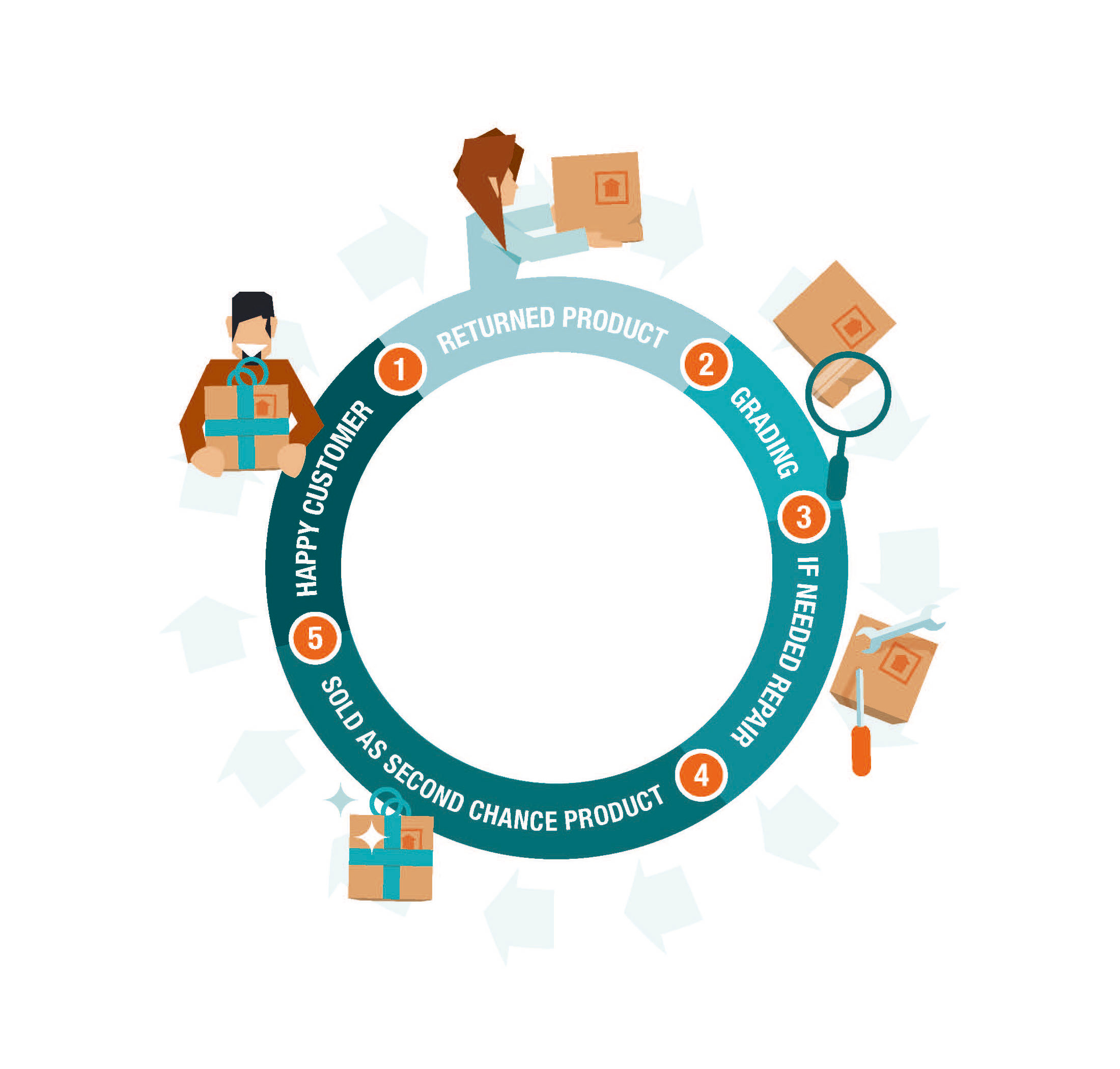The biggest unnecessary expense in e-commerce operations
To learn where organizations can find the biggest profit in dealing with returns management, we talked with all-round operational expert and Site Manager at BuyBay: John Warnar.

Dealing with returns is often an overshadowed part of the supply chain for suppliers and retailers. Especially since the common method of selling-off returns and excess goods to bulk buyers is not very lucrative. Additionally, it has fallen into disrepute due to environmental concerns linked to the issue of product destruction.
Environmental associations and politicians are calling for the so-called “duty of care for dealers” to be more firmly anchored in laws such as the German Recycling Management Act (KrWG). Vendors would then be forbidden to destroy electrical and electronic equipment before or after they had been returned by customers. This comes into play if the equipment could still be used after repair or reconditioning. In the future, vendors might also be required to keep records of all returns and their whereabouts and could be legally prosecuted if they violate the relevant guidelines. How should manufacturers and retailers implement this?
Large companies can try to modernize their internal processes with the help of returns management software. However, many companies do not have the resources to implement all necessary processes internally and to ensure the required transparency. They therefore often decide to work with partners to outsource (parts) of their return management process. But which partners are the best fit for managing returns and overstock? We have compiled a checklist with important criteria to watch when selecting a returns management partner.
Not only when considering whether the entire returns process can be implemented internally, but also when you have decided to work with partners, it is advisable to first take a look at your internal resources.
Where are the interfaces between your internal team and the external partners? Are there sufficient resources (personnel and time) available to work with different partners for different areas of returns management or should one partner ideally cover all areas? After this initial consideration, it is important to check which of the steps and services that you’d like to outsource can be handled by a partner.
If a customer decides to return a product, your first step is to check whether the item has been opened or used. If the item is completely untouched, it can immediately go back on stock for resale. The other returned items are most likely products with damaged or opened packaging, items that are clearly used or soiled, and non-functional products. These products can be sent directly to an external partner that records them and transfers them to their so-called “grading” process for quality control and classification. The sorting and grading of returns ideally cover an extensive check of each individual item in the returns flow. Does the partner offer this?

The next step should be an assessment to determine whether repair or reconditioning is profitable. In the case of high-quality products, respective treatments almost always make sense. A reliable, data-based system that takes the expected resale value of a product and the associated costs into account can significantly increase the profitability of returns management. It is therefore advised to check on what basis the assessment is carried out at the partner.
Another important question is which product and price segments are covered. Depending on the range of goods, up to 100 different types of inspection may be required. From a simple visual inspection to the test wash-cycle of a washing machine, a pixel test on 4K screens or professional data wiping for electronic and mobile devices. As with manufacturers or sales platforms, there are return service providers who specialize in certain segments. However, if you have a broad product range, you must take this into account when selecting a return management partner.
Product inspections should at least include a functional test, a functional description, cleaning and professional removal of all personal, identifiable information (PII) in accordance with EU data protection directives such as the GDPR. An intelligent and automated assignment of necessary tests and procedures as well as the step-by-step support of the testers through appropriate solutions can simplify the process and increase the resale value considerably.
A detailed documentation (including photos) of any traces of usage or defects is just as important. The products may not be as good as new, but as long as the next customer has a clear idea of the condition of the product, it will be no problem. Ideally, a partner also has the resources to professionally repair all, or at least particularly important, product segments.

Another obvious selection criterion is the size of the warehouse, test centers and repair services that a partner can provide. These must be able to cope with your expected return volume and could ideally also cover the sale of overstock. In addition, it should be considered whether the partner offers flexible solutions, such as the option to scale the quantities of goods that will be processed. This is often needed for seasonal peaks, such as the Christmas season and the Cyberweek around “Back Friday”. But you might also have individual demand peaks – e.g. around special promotions or summer holiday offers, etc.
Once the products have passed quality checks, testing, grading and repackaging, they are ready for the next buyer. For this purpose, you should check which channels the return partner uses for resale. If possible, all three common channels should be covered: public marketplaces, at least one auction platform and the option of selling the returned goods in a shop or section on your own website. In this context, it is advisable to review how the partner selects the most suitable channel and whether he determines this for individual products or for entire batches. In addition, it is important to find optimal pricing for the balance between resale value and the right sales volume. The use of an automated, data-driven and self-learning system can significantly increase the profit from returns.
A positive shopping experience and excellent customer service are key factors for customer loyalty and acquisition. This also applies to the resale of returns or overstock. Does the partner provide a service team that can answer questions from customers about the products and any defects they may have – before and after the purchase?

Knowing what is happening with each individual product is also becoming more and more relevant in the course of the “duty of care” as part of the Recycling Management Act mentioned in the introduction paragraph. In the case of bulk buyers, commonly, retailers have no insight into what happens to their products after they have been sold off. When choosing a partner, it is therefore all the more relevant to check to what extent and in what way you can track the path of your products. This also includes what happens to defective products that can no longer be used – for example, whether they are properly disposed of or recycled. Ideally, you should always have the option to monitor in real time what exactly is happening with each individual product, e.g. through an online portal.
For both financial and environmental reasons, it is helpful if long transport routes can be avoided and the returns partner has branches that are not too far away from your own location. Further advantages arise if the partner covers several regions and sells to different countries in the EU, for example. As a seller, you can then determine in which countries your returns and overstock should be offered. Additionally, price-related benefits can arise for buyers if they e.g. buy returns from other countries – where there is sometimes a higher price level.
In addition to the technical, logistical and economic aspects, there are also soft factors that should not be underestimated. This includes the question of whether the ‘chemistry’ between the contact persons is right, but also whether the company cultures match. After all, to a certain extent, the partner’s service team will represent your brand as well. If you find similarities in the corporate culture and behavior or joint motivations – such as the topic of sustainability in retail – then you will likely feel well represented by that partner.
The checklist shows how many criteria there are to consider when it comes to finding a partner for your returns management process. But even after examining the aspects mentioned, only a test run or pilot project can show how well the cooperation works in everyday life. We therefore always recommend testing a solution with a large number of products. This way, you can observe how a potential partner handles the goods, what prices are achieved and how well the cooperation works in general. Benchmarking against your current used return process is also possible in this way.